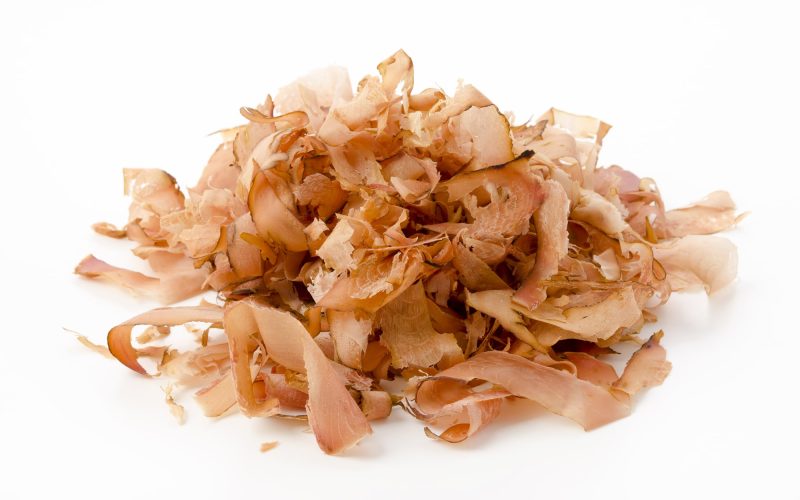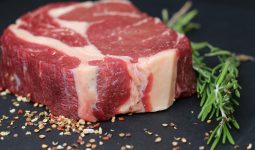Katsuobushi, or bonito flakes, are indispensable to Japanese cooking because they instantly improve savory foods by adding a powerful umami flavor boost.
It’s rare to locate something that tastes exactly like bonito flakes, so you’ll need to find the best bonito flakes substitutes when you run out.
Which alternatives to bonito flake are the best? Mackerel powder, dried shiitake mushrooms, kombu, dulse flakes, nori, and more are some of the greatest alternatives to bonito flakes.
Remember that the best bonito flake substitutes vary depending on your preparation and desired flavors!
The qualities of the best bonito flakes substitutes and how to use them in place of bonito flakes are all described below!
1. Powdered Mackerel
Powdered mackerel is starting our list of best bonito flakes substitutes.
They are comparable because both bonito flakes and mackerel powder are made from fish. Both in taste and texture, mackerel fish resemble bonito.
The distinction is that bonito flakes are larger than mackerel powder, which is finer.
But the flavor is similar, with an umami flavor reminiscent of fish that goes well with various dishes and recipes.
Mackerel powder is arguably the closest alternative for bonito flakes in terms of flavor, so if flavor replication is all that matters to you, this is certainly the best choice.
Since it’s a powder, you could start with a little less than you would with bonito flakes, but it’s best bonito flakes substitutes to start small and taste the dish as you go.
Once you add too much, it is hard to make the meal right again, but you can always add more.
2. Dried Shiitake Mushrooms
Since dried shiitake mushrooms are easy to get and provide a nice umami flavor to various meals, they make one of the best substitutes for bonito.
When making vegetarian dashi, these dried mushrooms are a popular choice since they add a nice umami flavor without requiring the use of fish products.
Dried shiitake mushrooms can be used in fried rice and seafood dishes, and they can be used to make soups and noodle dishes in addition to preparing dashi.
Although fresh shiitake mushrooms can be used, dried ones are easier to get and have a more intense umami flavor (they also keep longer in the pantry).
You can use about the same amount of dried shiitake mushroom as bonito flakes; however, you may want to start with less, gradually increase it, and then adjust the taste.
3. Kombu
Dry-packed edible brown algae, or kombu, is a common ingredient in dashi and other recipes that call for bonito flakes.
These best bonito flake substitutes can be used on their own to provide umami flavor to a meal, even though they can be combined with bonito flakes.
Some individuals enjoy the rather chewy texture of kombu, but others don’t.
You can soak the algae to soften it if you don’t like its chewy texture.
This works well on its own to make a variety of various foods, so it’s a wonderful option if you’re searching for the best bonito flakes substitutes.
4. Nori/Dulse Flakes
Although nori and dulse flakes are two different ingredients, we have put them together as the best bonito flakes substitutes because of their similarities.
Both are marine plants; nori, a seaweed, can also have a slight crispness when dried, and dulse flakes are a type of sea plant with great crispness.
Although not as intense as bonito flakes alone. Both nori and dulse flakes have an umami taste. But they also work well as a vegetarian or vegan replacement in various recipes.
While you could use nori or dulse flakes alone, combined, they offer a more complex and robust umami flavor that works well with various dishes.
5. Little Anchovies
Baby anchovies are the best bonito flake substitutes when cooking a broth or soup because of their strong, salty, fishy flavor.
Since dried baby anchovies have a stronger flavor and a texture more akin to bonito flakes, they are the ideal kind to use.
Additionally, you won’t have to stress about preparing the young anchovies ahead of time for a recipe.
The umami flavor of the tiny anchovies is enhanced during manufacturing since they are boiled before being dried.
If you would have used bonito flakes instead of baby anchovies, cut a few small dried anchovies till you have about the same amount that would have been required.
Just be aware that they are rather salty, so you may want to modify your cooking accordingly.
6. Soybeans
You can use toasted soybeans for bonito flakes when making dashi, but the umami flavor of the soybean-based dashi is softer and more subdued.
In fact, using soybeans to produce dashi or other meals lets the other flavors shine through without taking center stage.
You can acquire some flavor from the best bonito flakes substitutes since they taste better after toasting.
And they have a richer flavor than plain soybeans. Soybeans are a great option for people who like a softer, more delicate supper rather than one that tastes like fish or mushrooms.
Because toasted soybeans have a softer flavor than bonito flakes, you can use a little more of them, but always taste as you go!
7. Nutritional Yeast
Although nutritional yeast isn’t an often used component in Japanese cuisine, it can nonetheless serve as a viable substitute for bonito flakes.
It is frequently used as the best bonito flakes substitute as a topping for savory meals, including noodles, tofu, and others.
One advantage of utilizing nutritional yeast is that it naturally has a strong umami flavor, which is what you would want in a bonito flakes replacement.
Although it doesn’t taste fishy, some people may find this to be an advantage.
Another advantage of utilizing nutritional yeast is that it won’t significantly alter the texture of your food because it is primarily a powder that mixes in nicely with other ingredients without being overly crunchy.
8. Fish Shell
The same rich, fishy, and deep umami flavor of the bonito flakes is added to your recipe using shellfish such as dried prawns, scallops, and clams.
You may expect an exhilarating sensory experience that will leave you wanting more.
The nicest aspect is that they are just as adaptable as other fish.
You can cook them to make a flavorful and rich dashi soup or shave them over fried rice, noodle dishes, or your favorite recipes.
9. Tamarind
Japanese soy sauce, known as tamarind, has a deep, umami-flavor taste. It is ideal as one of the best bonito flake substitutes because of its features.
It is made from fermented soy sauce, but unlike regular soy sauce, it is a little thicker and darker.
You can substitute tamarind for katsuobushi by simply adding a tiny amount to your dish and adjusting the salt to taste.
Since tamari has a richer flavor than ordinary soy, a little goes a long way.
Conclusion
Bonito flakes add a powerful umami flavor to various dishes and are essential to the preparation of dashi, so they are a common component in Japanese cuisine.
Finding bonito flakes might be challenging if a specific Japanese store isn’t nearby, so you may need to explore other options.
You can choose from the best bonito flakes substitutes listed above, each with a slightly different flavor and texture, so you’re sure to discover the one that works best for you!









Great article! I live in Alaska and always substitute shiitake for foraged and dried Porcini. I’m going to try in in dashi also!